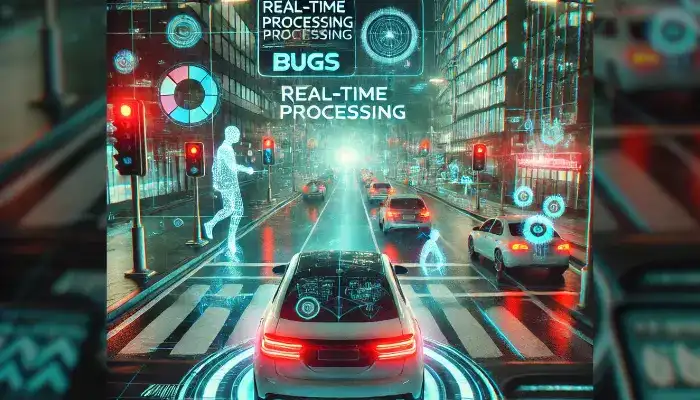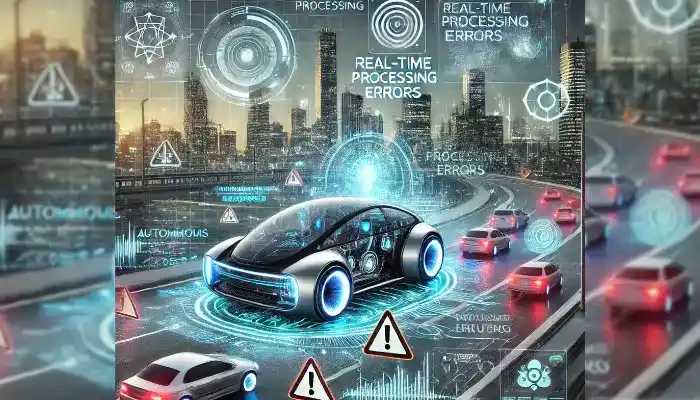Real-Time Processing Bugs in Autonomous Vehicles Autonomous vehicles (AVs) are now not an idea restricted to technology fiction they may be a reality, transforming the manner we reflect on considering transportation. These self-riding motors depend upon a mixture of superior technologies, inclusive of sensors, synthetic intelligence (AI), and actual-time processing systems, to navigate roads, keep away from limitations, and make break-up-2nd choices. However, like several complicated technologies, autonomous cars aren’t without their challenges. One of the most crucial troubles they face is the real-time processing of insects. These insects can disrupt the vehicle’s ability to function competently and effectively, potentially main to accidents or device screw-ups.
In this blog, we will take a detailed look at real-time processing bugs in autonomous vehicles. We will explore what they are, why they occur, their potential impact, and how the industry is working to address these challenges.
Understanding Bugs in Autonomous Vehicles and Their Impact?
Real-time processing is the backbone of autonomous vehicle technology. It refers to the system’s ability to process data and make decisions within a strict time frame often measured in milliseconds. For AVs, real-time processing involves three key steps:
Sensor Data Collection:
The autonomous vehicle is equipped with sensors, such as a camera, lidar (light detection and range), radar, and ultrasound sensors. These sensors are constantly sending information about the car environment, which includes the location of other cars, pedestrians, road signals, and obstacles.

Data Analysis and Decision-Making:
The information collected using sensors is sent to the computer on the car ship, which contacts the use of sophisticated AI algorithms. These analyze information to select algorithms, including when, promote brakes, steers, or alternative paths.
Execution:
When a decision is made, the vehicle’s control system completes the necessary tasks in real time. For example, if the system detects an obstacle, it can instruct the vehicle to break or sweat to avoid the collision.
The whole process from data collection to execution should be without delay and without delay. Any disturbance or errors in this process can cause treatment of real-time treatment, which can have serious consequences.
Types of Real-Time Processing Bugs
Real-time processing bugs can arise from a variety of sources, including software glitches, hardware malfunctions, and environmental factors. Let’s explore some of the most common types of bugs and their impact on autonomous vehicles.
Sensor Fusion Errors
Autonomous vehicles rely on many sensors to see the environment. The sensor merger is the process of combining data from these sensors to create an integrated and accurate representation of the environment. However, deviations in sensor data – such as timing that is not matching, calibration errors, or sensor errors – can lead to sensor reimbursement defects. These errors can result in results-PDF:
Environmental Interpretation in Autonomous Vehicles:
Vehicle barriers can be misunderstood, which can lead to incorrect navigation decisions. For example, it can make a shadow error for a barrier or fail to detect pedestrians crossing the road.
False positive/negative:
The vehicle can detect obstacles that do not exist (false positives) or fail to detect real obstacles (false negatives). Both landscapes can lead to dangerous conditions.
For more information on sensor calibration, check out this guide to sensor calibration in autonomous vehicles and improve bugs.
Latency Issues
Real-time processing requires that data be processed and acted upon within a specific time frame. Latency, or delay, in processing, can have severe consequences for Bugs in Autonomous Vehicles. For example:
Delayed Decision-Making:
If the decision-making algorithms of the vehicle are slow, the vehicle will not respond in time to prevent a collision. For example, if the system is slow to process sensor data, the vehicle will not be able to brake in time to prevent a collision with an obstacle.
Outdated Sensor Data:
If sensor information is not processed quickly enough, the car might be responding to information that is not current. This can result in poor decisions, like steering into a lane that is no longer open.
Algorithmic Errors
The algorithms used in autonomous vehicles are incredibly complex and must account for a wide range of scenarios. However, algorithmic errors can occur due to:
Incomplete Training Data: If the algorithms are trained on incomplete or biased data, they will not work effectively in real-world situations. for example, if there are not enough examples of pedestrians crossing during the night in the training data, the algorithm might not detect them in night conditions.
Edge Cases:
The algorithms can sometimes find it difficult to manage special or infrequent conditions, including unexpected road scenarios, non-routine pedestrian responses, or very unusual weather patterns. Edge cases are likely to produce the wrong decisions or may crash the system.
Hardware Failures
Autonomous cars depend on a range of hardware elements, such as processors, memory, sensors, and communication modules. Hardware malfunctions can interfere with real-time processing and result in:
System Crashes:
The onboard computer can crash due to a hardware failure, for example, a failed processor or sensor. This will leave the vehicle incapable of making decisions or taking action.
Data Corruption:
Data corruption due to hardware failures may result in wrong sensor readings or decision-making. for example, a malfunctioning sensor may report an incorrect location of an obstacle, causing a collision.
Environmental Factors
The environment in which an autonomous vehicle operates can also introduce real-time processing challenges. For example:
Adverse Weather Conditions:
At times of rain, snow, fog, and other bad weather, it can disrupt sensor data, making it more difficult for the vehicle to “see” around it. For example, heavy rain can distort LiDAR data, resulting in false obstacle detection.
Complex Urban Environments:
Traveling through congested city streets with numerous challenges, foot travelers, and other vehicles can overload the vehicle’s real-time processing ability. The system may not be able to handle the enormous amount of data produced in such situations, resulting in delays or mistakes.
Impact of Real-Time Processing Bugs in Autonomous Vehicles
The effects of real-time processing defects in driverless cars can be disastrous, varying from simple discomfort to death. Some possible effects include:
Accidents and Collisions:
Real-time processing faults can result in accidents, particularly if the car does not sense obstacles or makes navigation errors. For instance, a sensor fusion fault could result in the vehicle misjudging the location of another vehicle and causing a collision.
Loss of Public Trust:
Fatal accidents resulting from real-time processing glitches can cause a loss of public confidence in autonomous vehicle technology. This can hamper the growth of the industry and delay the adoption of AVs.
Legal and Regulatory Issues:
Autonomous vehicle accidents can generate legal and regulatory issues, such as lawsuits and tighter regulations. This can be an added challenge for manufacturers and decelerate the pace of development of AV technology.
How the Industry is Tackling Real-Time Processing Bugs in Autonomous Vehicles
Given the potential consequences of real-time processing bugs, it is crucial to develop strategies to mitigate these issues. The autonomous vehicle industry is actively working to address these challenges through various approaches:
Rigorous Testing and Validation
Manufacturers are investing heavily in testing and validation to identify and fix real-time processing bugs. This includes:
Simulation Testing:
Advanced simulators recreate countless driving situations, including unusual edge cases, to try out the vehicle’s performance. This enables manufacturers to detect and fix bugs in a controlled setting before the vehicle is released.
Real-World Testing: Self-driving cars are tested in all types of environments, from peaceful suburbs to crowded cities, to make sure they can handle real-world scenarios. This enables manufacturers to detect bugs that may not show up in simulations.
Redundancy and Fail-Safe Mechanisms
To minimize the impact of real-time processing bugs, autonomous vehicles are designed with redundancy and fail-safe mechanisms. For example:
Fail-Safe Modes: If there is a critical failure, the car can safely pull over or stop. This prevents the car from running in an unsafe condition.
Redundant Sensors:
Having multiple sensors guarantees that if one sensor fails, others can compensate. For example, if a camera fails, LiDAR and radar can continue to supply information regarding the surroundings of the car.
Continuous Software Updates
Software updates are regularly pushed to autonomous vehicles to fix bugs and improve performance. This includes:
Visit Automotive Quest for a Deep understanding
Over-the-Air (OTA) Updates:
These allow manufacturers to update the vehicle’s software remotely, ensuring it always runs the latest, most secure version. OTA updates can address bugs, improve algorithms, and add new features.
Improving AI and Machine Learning
Advancements in AI and machine learning are helping to make autonomous vehicles smarter and more reliable. This includes:
Better Training Data:
Using diverse and comprehensive training data helps algorithms perform better in real-world situations. For example, training data that includes a wide range of weather conditions, road types, and pedestrian behaviors can improve the algorithm’s ability to handle different scenarios.
Adaptive Algorithms:
These algorithms can learn from new experiences and adapt to changing conditions. For instance, an adaptive algorithm might improve its ability to detect pedestrians in low-light conditions over time.
Explore In-Depth Challenges and Advancements:
For further insights into the challenges faced by Bugs in Autonomous Vehicles, especially in testing and development, visit this comprehensive overview of challenges and advancements in testing autonomous vehicles.
Summary
Bugs in real-time processing pose a big challenge for self-driving cars, but we can overcome them. As technology keeps getting better, along with thorough testing and teamwork across the industry, we’re getting closer to a future where autonomous vehicles are safe, dependable, and used by many people. As we keep coming up with new ideas fixing these bugs will stay at the top of our to-do list. In the end, for self-driving cars to succeed, they need to do more than just drive – they need to drive safely.
For more posts you can visit: Techonboom

